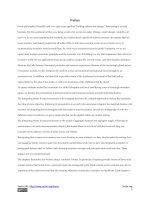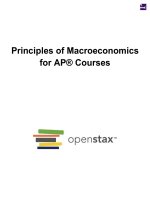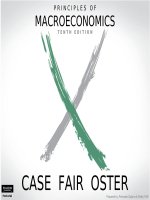Principles of macroeconomics 10e by case fair oster ch11
Bạn đang xem bản rút gọn của tài liệu. Xem và tải ngay bản đầy đủ của tài liệu tại đây (773.72 KB, 39 trang )
PRINCIPLES OF
MACROECONOMICS
PART III The Core of Macroeconomic Theory
TENTH
EDITION
CASE FAIR OSTER
© 2012 Pearson Education, Inc. Publishing as Prentice Hall
Prepared by: Fernando Quijano & Shelly
1 ofTefft
25
PART III The Core of Macroeconomic Theory
© 2012 Pearson Education, Inc. Publishing as Prentice Hall
2 of 39
Money Demand and
the Equilibrium
Interest Rate
11
CHAPTER OUTLINE
Interest Rates and Bond Prices
The Demand for Money
The Transaction Motive
The Speculation Motive
The Total Demand for Money
The Effect of Nominal Income on the Demand for Money
PART III The Core of Macroeconomic Theory
The Equilibrium Interest Rate
© 2012 Pearson Education, Inc. Publishing as Prentice Hall
Supply and Demand in the Money Market
Changing the Money Supply to Affect the Interest Rate
Increases in P • Y and Shifts in the Money Demand Curve
Zero Interest Rate Bound
Looking Ahead: The Federal Reserve and Monetary
Policy
Appendix A: The Various Interest Rates in the U.S.
Economy
Appendix B: The Demand for Money: A Numerical
Example
3 of 39
Interest Rates and Bond Prices
interest The fee that borrowers pay to lenders for the use of their funds.
Firms and governments borrow funds by issuing bonds, and they pay interest to
the lenders that purchase the bonds.
PART III The Core of Macroeconomic Theory
When interest rates rise, the prices of existing bonds fall.
© 2012 Pearson Education, Inc. Publishing as Prentice Hall
4 of 39
E C O N O M I C S I N PRACTI C E
Professor Serebryakov Makes an Economic Error
PART III The Core of Macroeconomic Theory
In Chekhov’s play Uncle
Vanya, Alexander
Vladimirovitch Serebryakov, a
retired professor, but
apparently not of economics,
calls his household together
to propose the following:
…Our estate yields on an
average not more than two
per cent, on its capital value. I
propose to sell it. If we invest
the money in suitable securities, we should get from four to five per cent, and I
think we might even have a few thousand roubles to spare…
Uncle Vanya tried to kill Professor Serebryakov for this idea, but no one
pointed out that this was bad economics and not a scheme.
Perhaps had Uncle Vanya taken an introductory economics course and
known this, he would have been less agitated.
© 2012 Pearson Education, Inc. Publishing as Prentice Hall
5 of 39
The Demand for Money
When we speak of the demand for money, we are concerned with how much of
your financial assets you want to hold in the form of money, which does not
earn interest, versus how much you want to hold in interest-bearing securities
such as bonds.
PART III The Core of Macroeconomic Theory
The Transaction Motive
transaction motive The main reason that people hold money—to
buy things.
nonsynchronization of income and spending The mismatch
between the timing of money inflow to the household and the timing of
money outflow for household expenses.
© 2012 Pearson Education, Inc. Publishing as Prentice Hall
6 of 39
The Demand for Money
PART III The Core of Macroeconomic Theory
The Transaction Motive
FIGURE 11.1 The Nonsynchronization of Income and Spending
Income arrives only once a month, but spending takes place
continuously.
© 2012 Pearson Education, Inc. Publishing as Prentice Hall
7 of 39
The Demand for Money
PART III The Core of Macroeconomic Theory
The Transaction Motive
FIGURE 11.2 Jim’s Monthly Checking Account Balances: Strategy 1
Jim could decide to deposit his entire paycheck ($1,200) into his checking account
at the start of the month and run his balance down to zero by the end of the
month.
In this case, his average balance would be $600.
© 2012 Pearson Education, Inc. Publishing as Prentice Hall
8 of 39
PART III The Core of Macroeconomic Theory
Jim receives $1,200 per month (30 days) and spends $40 each
day. What is his average money balance?
a.
$40.
b.
$30.
c.
$600.
d.
$1,200.
© 2012 Pearson Education, Inc. Publishing as Prentice Hall
9 of 39
PART III The Core of Macroeconomic Theory
Jim receives $1,200 per month (30 days) and spends $40 each
day. What is his average money balance?
a.
$40.
b.
$30.
c.
$600.
d.
$1,200.
© 2012 Pearson Education, Inc. Publishing as Prentice Hall
10 of 39
The Demand for Money
FIGURE 11.3 Jim’s Monthly Checking Account Balances: Strategy 2
Jim could also choose to put half of his paycheck into his
checking account and buy a bond with the other half of his
income.
At midmonth, Jim would sell the bond and deposit the $600 into
his checking account to pay the second half of the month’s bills.
Following this strategy, Jim’s average money holdings would be
$300.
PART III The Core of Macroeconomic Theory
The Transaction Motive
© 2012 Pearson Education, Inc. Publishing as Prentice Hall
11 of 39
The Demand for Money
PART III The Core of Macroeconomic Theory
The Transaction Motive
FIGURE 11.4 The Demand Curve for Money Balances
The quantity of money demanded (the amount of money households and firms want to hold) is a
function of the interest rate.
Because the interest rate is the opportunity cost of holding money balances, increases in the
interest rate reduce the quantity of money that firms and households want to hold and decreases
in the interest rate increase the quantity of money that firms and households want to hold.
© 2012 Pearson Education, Inc. Publishing as Prentice Hall
12 of 39
PART III The Core of Macroeconomic Theory
Assume that there are no management costs associated with
buying and selling bonds. What is the impact of an increase in the
interest rate on money holdings and interest revenue?
a.
Both money holdings and interest revenue would rise.
b.
Both money holdings and interest revenue would decline.
c.
Money holdings would rise and interest revenue would
decline.
d.
Money holdings would decline, and interest revenue
would rise.
© 2012 Pearson Education, Inc. Publishing as Prentice Hall
13 of 39
PART III The Core of Macroeconomic Theory
Assume that there are no management costs associated with
buying and selling bonds. What is the impact of an increase in the
interest rate on money holdings and interest revenue?
a.
Both money holdings and interest revenue would rise.
b.
Both money holdings and interest revenue would decline.
c.
Money holdings would rise and interest revenue would
decline.
d.
Money holdings would decline, and interest revenue
would rise.
© 2012 Pearson Education, Inc. Publishing as Prentice Hall
14 of 39
The Demand for Money
The Speculation Motive
PART III The Core of Macroeconomic Theory
speculation motive One reason for holding bonds
instead of money: Because the market price of interestbearing bonds is inversely related to the interest rate,
investors may want to hold bonds when interest rates are
high with the hope of selling them when interest rates fall.
© 2012 Pearson Education, Inc. Publishing as Prentice Hall
15 of 39
The Demand for Money
The Total Demand for Money
The total quantity of money demanded in the economy is the sum of
the demand for checking account balances and cash by both
households and firms.
PART III The Core of Macroeconomic Theory
At any given moment, there is a demand for money—for cash and
checking account balances. Although households and firms need to
hold balances for everyday transactions, their demand has a limit.
For both households and firms, the quantity of money demanded at
any moment depends on the opportunity cost of holding money, a cost
determined by the interest rate.
© 2012 Pearson Education, Inc. Publishing as Prentice Hall
16 of 39
PART III The Core of Macroeconomic Theory
Which of the following is a better measure of the opportunity cost
of holding money balances?
a.
The demand for money curve.
b.
The interest rate.
c.
The transactions motive.
d.
The optimal money balance.
© 2012 Pearson Education, Inc. Publishing as Prentice Hall
17 of 39
PART III The Core of Macroeconomic Theory
Which of the following is a better measure of the opportunity cost
of holding money balances?
a.
The demand for money curve.
b.
The interest rate.
c.
The transactions motive.
d.
The optimal money balance.
© 2012 Pearson Education, Inc. Publishing as Prentice Hall
18 of 39
E C O N O M I C S I N PRACTI C E
ATMs and the Demand for Money
PART III The Core of Macroeconomic Theory
Italy makes a great case study of the
effects of the spread of ATMs on the
demand for money. In Italy, virtually all
checking accounts pay interest. What
doesn’t pay interest is cash.
The study found that the demand for
cash responds to changes in the
interest rate paid on checking
accounts. The higher the interest rate,
the less cash held.
In other words, when the interest rate
on checking accounts rises, people go
to ATM machines more often and take
out less in cash each time, thereby
keeping, on average, more in checking
accounts earning the higher interest
rate.
© 2012 Pearson Education, Inc. Publishing as Prentice Hall
19 of 39
The Demand for Money
PART III The Core of Macroeconomic Theory
The Effect of Nominal Income on the Demand for Money
FIGURE 11.5 An Increase in Nominal Aggregate Output
(Income) (P •Y) Shifts the Money Demand Curve to the Right
© 2012 Pearson Education, Inc. Publishing as Prentice Hall
20 of 39
The Demand for Money
The Effect of Nominal Income on the Demand for Money
The demand for money depends negatively on the interest rate, r, and
positively on real income, Y, and the price level, P.
TABLE 11.1 Determinants of Money Demand
1. The interest rate: r (The quantity of money demanded is a negative
function of the interest rate.)
PART III The Core of Macroeconomic Theory
2. Aggregate nominal output (income) P • Y
a. Real aggregate output (income): Y (An increase in Y shifts the
money demand curve to the right.)
b. The aggregate price level: P (An increase in P shifts the money
demand curve to the right.)
© 2012 Pearson Education, Inc. Publishing as Prentice Hall
21 of 39
PART III The Core of Macroeconomic Theory
The demand for money increases when:
a.
Both the dollar volume of transactions and the average
transaction amount increase.
b.
Both the dollar volume of transactions and the average
transaction amount decrease.
c.
The dollar volume of transactions increases and the average
transaction amount decreases.
d.
The dollar volume of transactions decreases and the average
transaction amount increases.
© 2012 Pearson Education, Inc. Publishing as Prentice Hall
22 of 39
PART III The Core of Macroeconomic Theory
The demand for money increases when:
a.
Both the dollar volume of transactions and the average
transaction amount increase.
b.
Both the dollar volume of transactions and the average
transaction amount decrease.
c.
The dollar volume of transactions increases and the average
transaction amount decreases.
d.
The dollar volume of transactions decreases and the average
transaction amount increases.
© 2012 Pearson Education, Inc. Publishing as Prentice Hall
23 of 39
The Equilibrium Interest Rate
We are now in a position to consider one of the key questions in
macroeconomics: How is the interest rate determined in the economy?
PART III The Core of Macroeconomic Theory
The point at which the quantity of money demanded equals the quantity of
money supplied determines the equilibrium interest rate in the economy.
© 2012 Pearson Education, Inc. Publishing as Prentice Hall
24 of 39
The Equilibrium Interest Rate
Supply and Demand in the Money Market
PART III The Core of Macroeconomic Theory
FIGURE 11.6 Adjustments in the Money
Market
Equilibrium exists in the money market
when the supply of money is equal to
the demand for money and thus when
the supply of bonds is equal to the
demand for bonds.
At r0 the price of bonds would be bid
up (and thus the interest rate down).
At r1 the price of bonds would be bid
down (and thus the interest rate up).
© 2012 Pearson Education, Inc. Publishing as Prentice Hall
25 of 39









